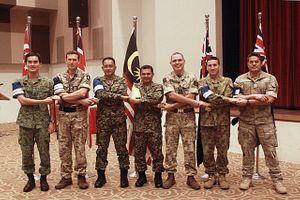Last week, the five countries that belong to the Five Power Defense Arrangements (FPDA) – Australia, Malaysia, New Zealand, Singapore, and the United Kingdom – completed yet another iteration of a military exercise as part of an ongoing cycle of drills. The exercise once again put the spotlight on the FPDA as a regional multilateral security arrangement.
As I have noted before in these pages, the FPDA was initially formed in 1971 to help defend Singapore and Malaysia after their independence following the withdrawal of British forces east of Suez. The FPDA, which has grouped Australia, Malaysia, New Zealand, Singapore, and the United Kingdom, remains the longest standing multilateral security arrangement in Southeast Asia today.
The FPDA includes a set of exercises that gradually took shape over the decades – starting with air exercises and then land and sea components in the 1970s and 1980s, and then followed by combined and tri-service exercises in the 1990s and 2000s that occur on a five-year cycle period.
Among these is Exercise Suman Warrior, the annual land-based exercise that is held among the five countries. The last iteration of Exercise Suman Warrior was hosted by the British Army in Wiltshire, United Kingdom from May to June in 2018. The 27th iteration of the exercise involved over 150 personnel from the five countries and came as the defense ministers from the FPDA countries had met during the 2018 iteration of the Shangri-La Dialogue, Asia’s premier security summit.
Earlier this month, the FPDA was in the headlines again with the holding of the latest iteration of Exercise Suman Warrior. The exercise, held from September 8 to September 20, was conducted in Australia and lasted from September 8 to September 20, following the rotational pattern of hosting that has been taking place with respect to the drills.
The exercise, which was hosted by the Australian Defense Force in Gallipoli Barracks in Brisbane, Australia, consisted of a series of interactions. Per Singapore’s defense ministry (MINDEF), this year’s iteration of the exercise saw representatives from the FPDA member states participate in a command post exercise focused on the planning of land-based operations.
Unsurprisingly, few additional specifics were available regarding the conduct of the FPDA exercise beyond that general characterization. But all in all, over 150 personnel participated in the exercise from Australia, Malaysia, New Zealand, Singapore, and the United Kingdom. That personnel number was about the same as last year, in yet another indication of the continuity within the longstanding multinational security agreement.

































